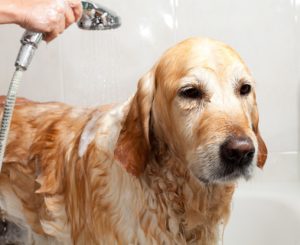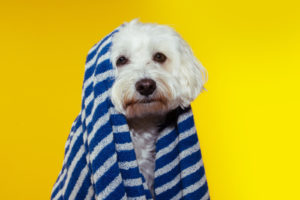Effective Relief for Your Dog’s Dry, Itchy Coat This Winter

By Arden Moore – The Pet Health and Safety Coach™
In our household, our three dogs sport very different coats. Little Emma, a whopping nine pounds, sports a silky greyish coat with little hair on her belly. Kona, our energetic terrier mix, has a wiry coat that sheds very little. And, then there is big Bujeau, our Bernese Mountain Dog mix, who requires regular brushing of her thick black coat that seems to puff out hair on our floors with her every step – and usually, right after we vacuum the house.
Yes, dogs come in all sizes and coat lengths and types. But all canines are at risk for dry, itchy coats as temperatures dip during the winter months.
You may feel relieved that the scratching is not due to a pesky flea that causes itching in the warm months, but still, your dog’s constant scratching is making her feel miserable. And, remember, that the skin is your dog’s largest organ, so when the skin is not at its shiny best, it can impact your dog’s overall health.
First, let’s identify some common culprits triggering dry, flaky skins in dogs:
- Spending more time indoors. Your dog bounds outside for needed potty breaks and maybe even play time in the winter. He then scoots back inside your home that is toasty warm with dry hair piping out the heater vents. This forced warm air can cause your dog’s skin to dry and become itchy. The increase of time spent indoors during the winter months exposes your dog to an increase in dust mites, pet dander, mold and other indoor allergies that can trigger itching flare ups.
- Chowing on low-quality commercial pet food. Just like us, some dogs have allergies to certain foods (as well as allergies to grass or pollen) that may trigger itchy coats. In addition, dogs fed diets that lack quality ingredients pay the price with dried out coats that trigger the itching episodes. Consult your veterinarian about diets that contain the right proteins and other ingredients based on your dog’s age, health condition, breed and activity level. In addition, discuss supplements containing essential Omega-6 fatty acids, vitamin E oil and digestive enzymes that may boost your dog’s coat quality.
- Coping with s-t-r-e-s-s and other emotional issues. Some dogs, especially now during this never-ending pandemic, may become bored, feeling confined or even overly anxious. They may start to gnaw on their paws or chew on their tails and backs in an effort to calm down. Unfortunately, the paws and coats pay the price with reddened paw pads, skin abrasions and even painful hot spots. Take the time to do regular head-to-tail wellness checks on our dog at least weekly to catch any early signs of skin distress that may be treated promptly – and at less cost – at the veterinary clinic.
- Enduring too little or too much at-home grooming. All dog coats benefit from brushing, combing and baths that rid the coat of dead hair and skin flakes and restore the coat with needed essential oils. Work with your veterinarian on picking the right grooming tools and schedule for your dog, based on her coat.
THE ART OF BRUSHING
 Armed with the right brush your dog’s coat type unleashes many health benefits. The brush stroking acts like a natural moisturizer by stimulating the skin’ oil-producing glands to keep them from becoming overly dry. Brushing also puts the ‘b’ in bonding. Brush your dog when you are calm and relaxed to help your dog become more relaxed and trusting of being handled. Dogs used to be brushed and petted with a purpose are better patients in the veterinary exam room and welcomed clients at dog grooming salons.
Armed with the right brush your dog’s coat type unleashes many health benefits. The brush stroking acts like a natural moisturizer by stimulating the skin’ oil-producing glands to keep them from becoming overly dry. Brushing also puts the ‘b’ in bonding. Brush your dog when you are calm and relaxed to help your dog become more relaxed and trusting of being handled. Dogs used to be brushed and petted with a purpose are better patients in the veterinary exam room and welcomed clients at dog grooming salons.
MAKING BATH TIME MORE WELCOMING
You will need to bathe your dog less frequently in the winter than the summer to manage his dry skin. Veterinarians also recommend that you use a humidifier in your home to keep the air inside from being too dry and taxing on not only your dog’s coat, but also your skin.
Little Emma is best bathed in our large kitchen sink that has a non-skid mat. I make sure the water from the nozzle is warm before placing Emma in the sink. Kona and Bujeau are better suited for baths inside our large, walk-in shower with a hand spray muzzle. For each, I speak sweetly and calmly to make them feel like they are being pampered with a healthy purpose.
 To ensure a pleasant, healthy experience, I place the towels, shampoo, conditioner and of course, a handful of tasty treats within arm’s reach before I call for my dog. Especially in the winter if my dogs have dry skin, my go-to choice bathing products are the ZYMOX® Shampoo and the ZYMOX Leave-On Conditioner. Both products are void of any harsh detergents or harmful by-products, such as parabens. Both are antibiotic free and contain enzymes that effectively control microbial growth on the skin and coat without harming healthy skin cells. The conditioning rinse is non-greasy and moisturizes the coat with vitamin D to rejuvenate the dried-out coat. Nice, right?
To ensure a pleasant, healthy experience, I place the towels, shampoo, conditioner and of course, a handful of tasty treats within arm’s reach before I call for my dog. Especially in the winter if my dogs have dry skin, my go-to choice bathing products are the ZYMOX® Shampoo and the ZYMOX Leave-On Conditioner. Both products are void of any harsh detergents or harmful by-products, such as parabens. Both are antibiotic free and contain enzymes that effectively control microbial growth on the skin and coat without harming healthy skin cells. The conditioning rinse is non-greasy and moisturizes the coat with vitamin D to rejuvenate the dried-out coat. Nice, right?
And, I like that once I towel dry and brush my dogs, their coats smell pleasingly pleasant and not overpowering. ZYMOX products are available from your veterinary clinic or select pet specialty stores as well as the soon-to-open ZYMOX Store from its manufacturer, Pet King Brands.
Okay, doggies, who is ready for a bath?
 Arden Moore wears many collars in the pet world. She is a best-selling author, master certified pet first aid/CPR instructor, pet behavior consultant, host of the Oh Behave Show on Pet Life Radio and happy pet parent to a Furry Brady Bunch in Dallas. Learn more at www.ardenmoore.com.
Arden Moore wears many collars in the pet world. She is a best-selling author, master certified pet first aid/CPR instructor, pet behavior consultant, host of the Oh Behave Show on Pet Life Radio and happy pet parent to a Furry Brady Bunch in Dallas. Learn more at www.ardenmoore.com.

